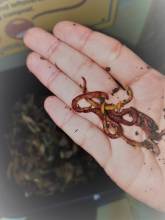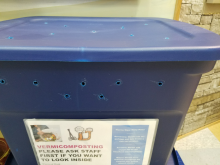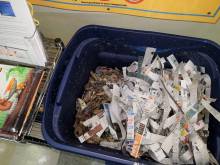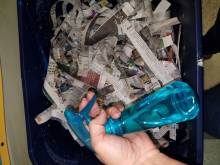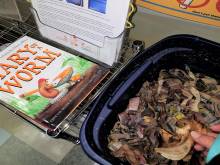Vermicomposting
- Find a tote and tray for the worm's new home.
- Tote should keep light out - dark plastic, wooden or other container (except metal).
- A 16 gallon tote is a good size to start with.
- A tray under the tote is recommended for drainage.
- Gather bedding and a spray bottle.
- Use carbon material (leaves, cardboard, shredded newspaper, straw, moss, aged manure or compost) for bedding.
- Fill the spray bottle with water.
- Find worms!
- You’ll want to request “Red Wigglers” or “Eisenia Fetida”.
- Many seasoned vermicomposters have worms available to donate.
- Post on nextdoor.com or a social media group to ask for worms.
- Call Fort Collins Nursery or contact the “Worm Man” through cowormman.org.
- Lastly, contact CSU extension for local resources. Bait shops might have some for sale.
- Drill holes.
- Make ¼” air holes in the tote lid, on all four sides of the bin (top ¼ of tote), and on the bottom, for drainage
- Holes should be 1’ - 1 ½” apart
- Add your bedding and wet it.
- Fill the bin about halfway with bedding. Spray with water bottle until bedding is damp.
- Moisture level should be that of a wrung out, wet sponge.
- Completely fill the bin with the remaining bedding and spray until damp.
- You have enough bedding when your bin is about ¾ of the way full.
- Add worms.
- Spread on top (shine light above the tote during the first night to encourage movement down).
- 3 - 5 days without food (give time to acclimate to new environment).
- Finishing touches
- Add a cup of sand to aid in worms’ digestion.
- Elevate the bin on a tray using small blocks of wood.
|
WHAT TO FEED WORMS: |
WHAT TO AVOID: |
|---|---|
|
|
- Consistency
- Try to add small pieces of food.
- It’s okay to feed food that’s slightly spoiled or moldy.
- Food placement
- Rotate the spot where food is placed each time you feed.
- Cover the food well with bedding to prevent odor and fruit flies.
- Feed regularly (about once a week).
- Keep worm bin in a location that stays between 50 - 75 degrees F. They will die if they get too hot or too cold.
- Keep bedding damp and fluffy.
- Each time you feed, add water if the bedding isn’t damp. Worms must stay moist to survive.
- Fluff bedding with hands to add space and air. They need room to move around.
- Add new bedding regularly to keep the bin full.
- Remove worm castings (dark brown material) and use them in your garden or on houseplants.
FAQs
-
How many worms should I use?
It is recommended that you start with a pound of red wigglers in a 15 gallon tote. However, if you begin with a smaller amount, you will soon have plenty of worms to consume more of your food scraps.
-
Why do I have fruit flies?
You may be feeding the worms more than they can eat. Reduce the amount of food you provide until you have more worms. (They reproduce quickly.) Be sure to cover food with plenty of bedding.
-
Why are my worms trying to escape?
Your worms may be in search of food. Provide them with soft food that is ready to be eaten (small pieces). Remember, worms don't have teeth so they can't take bites. It may also help to leave the lid off and shine a light at the top of the bin to encourage them to settle back into their home. Lastly, check the moisture level. It can't be too wet or too dry inside or the worms won't be happy.
-
Why does my bin smell bad?
Your bin may be too wet and/or not getting enough air. If the worm composting system becomes anaerobic, it will emit a bad odor. So, feed your worms drier food scraps for a while and make sure the bin has enough air all the way around it. Try fluffing up your bedding to introduce more oxygen and consider changing the bedding type as some materials clump up too much to allow air flow.
